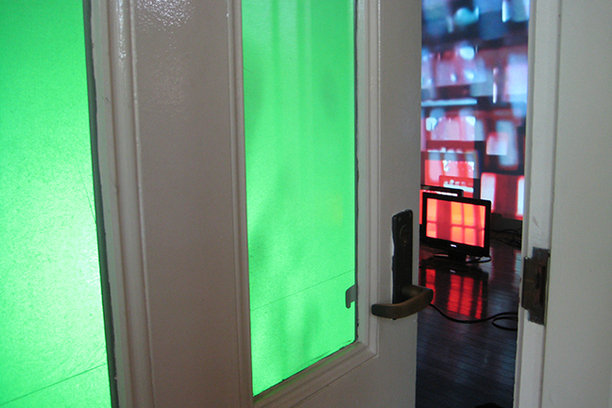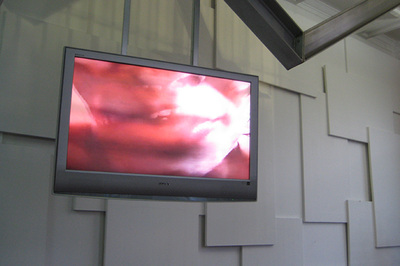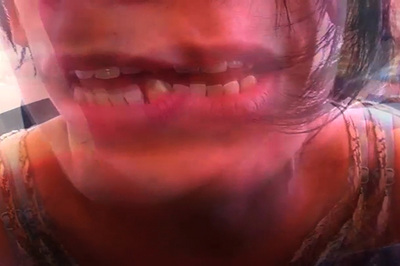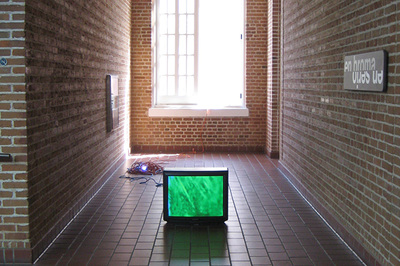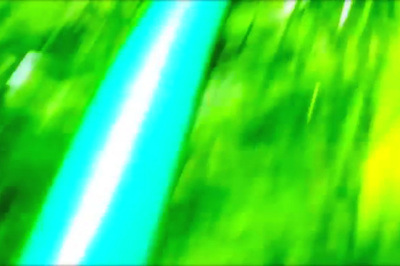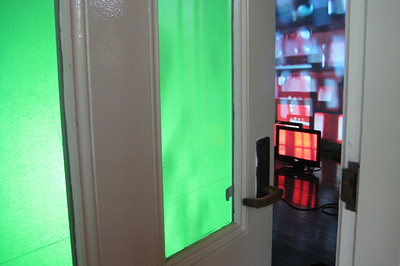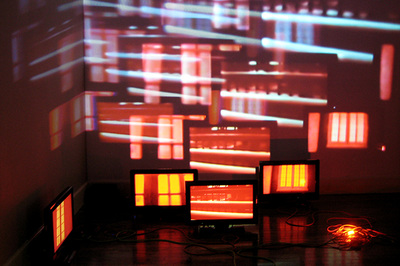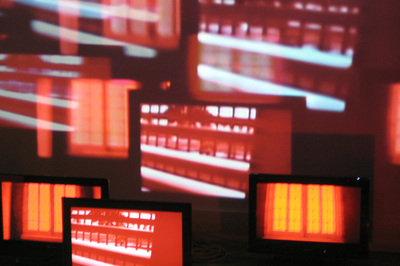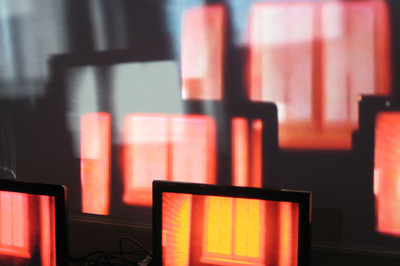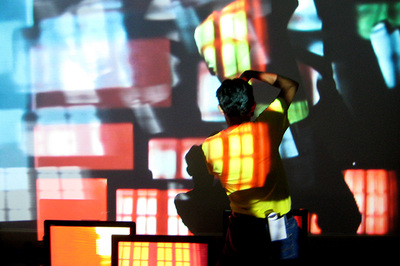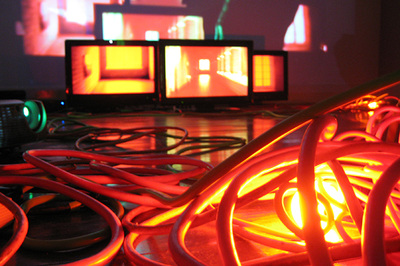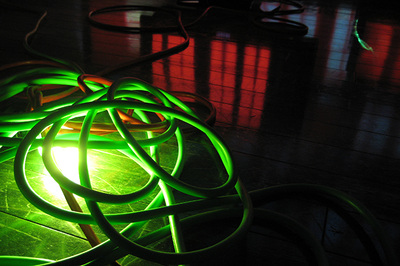|
Reverberación
This site-specific video-based project was produced during an artist residency at the Museum of Contemporary Art in San Juan, Puerto Rico in 2010. During her weeklong residency the artist used the museum as subject and context to produce a series of video installations intervening various spaces throughout the museum. Reverberación explored the concept of memory—its fragility, subjectivity and fragmented nature—through an examination of the building’s architecture and history. It was part of Taller Vivo: DocMAC, a series of residencies dealing with the concept of documentation and the idea of fast-production and fast-consumption, curated by Carmen Oquendo-Villar. The first video that welcomed the visitor played on the existing informational flat screen at the entrance. The video layered several close up shots of one of the museum’s greeters. This audiovisual echo served to introduce the rest of the project. A second video played on a monitor at the end of a hallway. In this video, which was shot on the museum’s grounds, the camera continuously followed a line though a grassy landscape. The continuous forward movement invited the viewer to follow it, pointing also to the electrical cables behind the monitor that continued towards the open window. This installation directly engaged the window, the journey towards it and what lied beyond it. In the project’s main installation on the second floor, a series of videos presented on flat-screens within a contained space focused on the building’s windows. Several projections visually reverberated the images on those screens through feedback using a video camera. The installation allowed for the viewer’s interactivity; the viewer’s body would alter the projected images, not only by creating a shadow but also by appearing, reverberated, on the walls in continuous movement. The windows pointed to the space/margin in between past and present, interior and exterior. The video feedback effect allowed the images to slowly decay as they multiplied infinitely, suggestive of memory’s persistence, fragility and fragmentation. The fact that the viewer could further alter and break up the projected imagery reemphasized these ideas, and pointed to the impossibility of trying to hold any one of these memories in place, since everything is in constant flux. The audio component contained layered voices of the artist’s family members who had studied in that building between the 1920’s and 1950’s when it was a public school. The audio had a similar effect as the visual component; one could understand words and phrases but could not follow a thread due to the layering and echo effect. The installation also included hundreds of feet of extension cords and light bulbs that were used to map and link the multiple components of the installation, suggestive of routes, veins and emphasizing interconnectivity. This project was funded partly by the National Endowment for the Arts, Oficina de Apoyo a las Artes y al Quehacer Cultural & Instituto de Cultura Puertorriqueña. Este proyecto de video in-situ fue producido durante una residencia artística en el Museo de Arte Contemporáneo en San Juan, Puerto Rico, en el 2010. La artista utilizó el museo como sujeto y como contexto para producir una serie de instalaciones de video interviniendo varios espacios del museo. Reverberación exploró el concepto de la memoria, su fragilidad, subjetividad y forma fragmentada, a través de una examinación de la arquitectura e historia del edificio. El proyecto fue parte del Taller Vivo: DocMac, una serie de residencias artísticas explorando el concepto de la documentación así como el consumo y producción rápida, curado por Carmen Oquendo-Villar. La primera obra que recibía al visitante era un video en la pantalla plana informativa que hay en la entrada. El video superponía varias tomas en primer plano de una de las anfitrionas del museo dando la bienvenida al mismo. Este eco audiovisual sirvió de introducción al resto del proyecto. Un segundo video se encontraba en un monitor al final del pasillo. En el mismo, que fue grabado en el patio del museo, la cámara sigue una línea sobre la grama. Este movimiento invitaba al espectador a seguirlo, continuando la travesía vía la extensión eléctrica conectada al monitor y que llega hasta la ventana abierta. Esta instalación destaca la ventana, la ruta hacia ella y lo que pueda haber al otro lado como enfoque conceptual. En la instalación principal del proyecto, en una de las galerías del segundo piso del museo, se presentaba una serie de pantallas planas con videos que exploraban las distintas ventanas del edificio. Varias proyecciones reverberaban visualmente las imágenes de esas pantallas a través del efecto de retroalimentación creado con una cámara de video. La instalación permitía interacción, ya que el cuerpo del espectador alteraba la imagen proyectada, no sólo con su sombra sino también con su aparición reverberada en continuo movimiento sobre las paredes. Las ventanas, metafóricamente, apuntaban al espacio/margen entre el pasado y el presente, interior y exterior. El efecto de retroalimentación permitía que las imágenes fueran deteriorándose según se multiplicaban infinitamente, apuntando hacia la persistencia de la memoria, su fragilidad y fragmentación. El hecho de que el espectador podía alterar y quebrar la imagen proyectada enfatizaba estas ideas, hablando sobre la imposibilidad de retener memorias como hechos ya que todo está en continuo estado de fluctuación. El audio de esta instalación contenía capas superpuestas de voces de familiares de la artista que estudiaron en este edificio entre 1920 y 1950, cuando era la Escuela Superior Rafael M. Labra. El audio tenía un efecto similar al componente visual; uno podía entender ciertas palabras o frases pero no era posible seguir el hilo de las historias dado el eco y la superposición de las voces. La instalación también incluyó cientos de pies de extensiones eléctricas con bombillas que servían de mapa y enlace entre los distintos componentes, evocando rutas, venas y enfatizando el concepto de interconectividad. Este proyecto recibió fondos del National Endowment for the Arts, la Oficina de Apoyo a las Artes y al Quehacer Cultural y el Instituto de Cultura Puertorriqueña. Reseña: La poesía de las paredes por Ana Teresa Toro |
|
|
_
|
